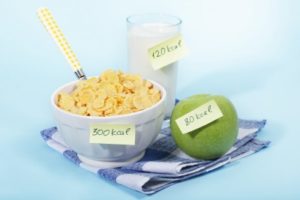 Ever wonder what a calorie really is? It’s the amount of energy it takes to raise the temperature of 1gram of water by 1o C. But did you know there is also a Calorie with a capital C? This is the amount of energy it takes to raise the temperature of 1kg of water 1o C so it’s a thousand times more energy than a calorie. To help reduce some of the confusion you will more commonly see it referred to as a Kcal or kilocalorie. In the metric system kilo anything is 1000; kilometers, kilograms, kilocalories.
Ever wonder what a calorie really is? It’s the amount of energy it takes to raise the temperature of 1gram of water by 1o C. But did you know there is also a Calorie with a capital C? This is the amount of energy it takes to raise the temperature of 1kg of water 1o C so it’s a thousand times more energy than a calorie. To help reduce some of the confusion you will more commonly see it referred to as a Kcal or kilocalorie. In the metric system kilo anything is 1000; kilometers, kilograms, kilocalories.
The energy requirement for a horse is referred to in megacalories or Mcal which is equal to 1000 Kcal or 1 million calories (think M for million or mega). On human food labels you will see that foods nutrition facts are based on a 2000 calorie or 2 Kcal per day diet. So if the average mature human requires approximately 2 Kcals to sustain body weight what about a horse? A mature 1100 lb (500 kg) horse that is not doing any work requires 16.7 Mcals per day to sustain body weight. That’s 8.35 times more energy than the human being.
So know we know that the unit used to measure energy is the calorie (note the Europeans use joules but that’s a whole different post) and that a horse needs a lot more calories each day than we do. However not all the calories you feed will end up in your horse because your horse is not able to fully utilize all the calories provided in each meal.
The total energy content of a feed is referred to as its gross energy (GE). This is calculated in the lab setting but putting the feed in what is called a bomb calorimeter which is a chamber inside of which the feed is combusted. Temperature change is measured and the gross energy content calculated.
Because digestion is not 100% efficient, some of that gross energy passes out of the digestive tract in the feces. What is digested and absorbed is referred to as the digestible energy (DE) content of the feed or ration. Once absorbed out of the digestive tract, some energy is lost in urine and some in gases. What remains is the metabolisable energy (ME), that which is available for metabolism. During the process of metabolism energy is lost in heat. None of the energy lost in feces, urine, gas of heat is available to your horse for maintaining body function, growth, reproduction, milk production etc. What you are ultimately left with for these purposes is known as net energy (NE).
While it would be ideal to create feeding programs around the net energy content of feeds, here in the US we build rations around the digestible energy and state a horse’s energy requirement in Mcal’s of digestible energy. Europe and in particular the French work more on a net energy basis. Why don’t we use the net energy system given it would be more accurate? This is an area of much debate in the Animal Sciences and in some livestock systems we are starting to see a shift. Getting all us professionals who are comfortable with the DE and system to shift to an NE system is going to take some time after all it can be hard to teach old dogs new tricks, but more importantly we just don’t have complete data available on the net energy content of feeds for horses in the US. So for now the National Research Council who set the nutrient requirements for horses in the US have decided to stay with the digestible energy system.
Why should you care about all this? You really don’t have to, but now when you see references made about the energy content of a feed in Mcal of DE per pound you will have some idea of what that actually means. Plus it is a great topic of conversation when you need to get out of talking to someone during the up-coming Holiday parties. Their eyes will glaze over and while they are looking completely baffled, you can make a hasty exit.
elvinphoto / 123RF Stock Photo

The Skinny on Energy Units and Terms by Dr. Clair Thunes and Summit Equine Nutrition LLC is licensed under a Creative Commons Attribution-NonCommercial-NoDerivs 3.0 Unported License.